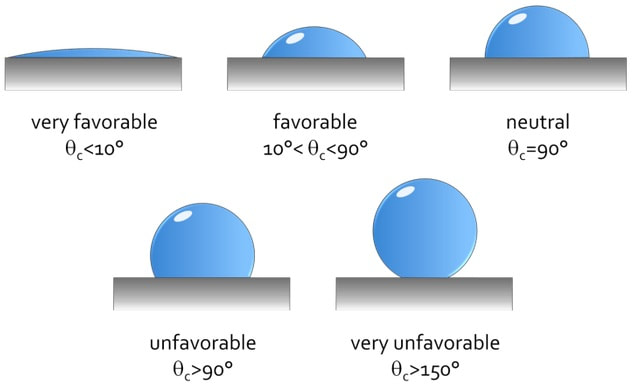Engineered cleaning fluids can be formulated to influence surface tension and wetting angle to optimize their cleaning performance on various surfaces, including printed circuit boards (PCBs). Here's how these fluids can affect these properties:
Surface Tension:
- Addition of Surfactants: Cleaning fluid formulations often include surfactants or surface-active agents. Surfactants are compounds that can lower the surface tension of the liquid. They contain both hydrophilic (water-attracting) and hydrophobic (water-repelling) parts, which help reduce the cohesive forces between liquid molecules, effectively lowering the surface tension.
- Selection of Surfactant Type: The choice of surfactant and its concentration in the cleaning fluid can be tailored to meet specific cleaning requirements. Some surfactants can reduce surface tension more effectively than others, allowing for control over the fluid's wetting properties.
- Balancing Surface Tension: Engineers can adjust the concentration and type of surfactants to balance the surface tension, ensuring it is low enough to promote efficient wetting and penetration of contaminants without causing excessive wetting or damage to sensitive components.
- Cleaning Efficiency: A lower surface tension in the cleaning fluid is generally desirable. A lower surface tension allows the cleaning fluid to spread more easily across the PCB's surface. This means that it can penetrate and dislodge contaminants, such as flux residues or solder paste, more effectively.
- Capillary Action: Low surface tension facilitates capillary action, which helps the cleaning fluid penetrate tight spaces, such as gaps between components or under SMDs (surface-mount devices).
- Minimizing Streaks: Low surface tension can reduce streaking on the PCB surface, ensuring that residues and contaminants are uniformly removed.
- Rinsing: When cleaning is complete, low surface tension is beneficial for rinsing. It aids in the removal of cleaning fluid residues, preventing unwanted residue buildup.
- Enhanced Wetting: A fluid with low surface tension is more likely to wet the entire surface, reaching and cleaning areas with complex topography.
Wetting Angle:
- Surfactant Formulation: The selection and concentration of surfactants also play a crucial role in modifying the wetting angle. Surfactants can enhance wetting by promoting the spread of the cleaning fluid over the surface of the PCB.
- Contact Angle Measurement: Engineers may measure the contact angle of the cleaning fluid on the PCB surface to assess its wetting properties. A smaller contact angle indicates better wetting.
- Contaminant Interaction: The presence of surfactants in the cleaning fluid can change the interaction between the fluid and the contaminants on the PCB's surface. This can facilitate the removal of residues and enhance wetting.
- Rinse Agents: Some cleaning processes may incorporate rinse agents to further reduce the wetting angle. Rinse agents can help ensure that residues are effectively removed without leaving watermarks.
- Optimal Wetting: The wetting angle is the angle at which the cleaning fluid contacts the PCB surface. A smaller wetting angle indicates better wetting, where the cleaning fluid spreads and adheres to the surface more effectively.
- Residue Removal: Effective wetting helps in breaking down and removing residues by ensuring that the cleaning fluid comes into close contact with contaminants. It can also prevent the formation of watermarks or residue patterns.
- Reduced Agglomeration: A small wetting angle can help prevent the formation of droplets, which can lead to agglomeration of contaminants. This is important for uniform cleaning.
- Compatibility with Surfaces: Wetting angle must be carefully balanced because if it's too low, it might lead to excessive wetting, which can damage sensitive components or lead to short circuits.
Substrate and Contaminant Compatibility:
- Engineers need to consider the type of substrate (PCB material) and the nature of contaminants when designing cleaning fluids. The formulation should be compatible with the specific materials and contaminants encountered to prevent damage or unwanted reactions.
- Selecting the right combination of surfactants and other components in the cleaning fluid is essential to achieve optimal wetting and surface tension adjustments for the given application.
Testing and Optimization:
- Engineers typically conduct thorough testing and optimization to ensure that the engineered cleaning fluid achieves the desired surface tension and wetting angle while effectively removing contaminants. This may involve testing various formulations and concentrations.
The goal of engineering cleaning fluids is to create a formulation that balances these factors to achieve efficient and effective cleaning results without harming the PCB or its components. Proper formulation and testing are critical to ensure the cleaning fluid meets specific cleaning requirements while maintaining substrate and component integrity.
In practice, PCB cleaning fluids are often formulated with surfactants to lower the surface tension and enhance wetting. These surfactants can modify wetting angles, improving the overall cleaning process.
It's important to note that the specific requirements for PCB cleaning fluids can vary depending on the type of contaminants, the PCB materials, and the cleaning method used. Therefore, when engineering PCB cleaning fluids, it's crucial to consider the unique needs of the application and conduct thorough testing to ensure that the chosen cleaning solution effectively removes contaminants while not causing damage to the PCB or components.
In practice, PCB cleaning fluids are often formulated with surfactants to lower the surface tension and enhance wetting. These surfactants can modify wetting angles, improving the overall cleaning process.
It's important to note that the specific requirements for PCB cleaning fluids can vary depending on the type of contaminants, the PCB materials, and the cleaning method used. Therefore, when engineering PCB cleaning fluids, it's crucial to consider the unique needs of the application and conduct thorough testing to ensure that the chosen cleaning solution effectively removes contaminants while not causing damage to the PCB or components.
|
Return to home page
|

